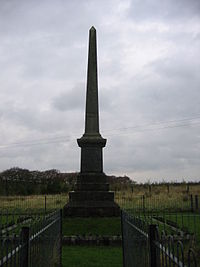Battle of Drumclog
| Battle of Drumclog | |||||||
|---|---|---|---|---|---|---|---|
| Part of Scottish Covenanter Wars | |||||||
 Monument to the Battle of Drumclog |
|||||||
|
|||||||
| Belligerents | |||||||
|
|
|
||||||
| Commanders and leaders | |||||||
|
|
|
||||||
|
|
|||||||
The Battle of Drumclog was fought on 1 June 1679, between a group of Covenanters and the forces of John Graham of Claverhouse, at Drumclog, in South Lanarkshire, Scotland.
Following the assassination of Archbishop James Sharp on Magus Muir, and the Declaration of Rutherglen, the Covenanters were on the verge of open rebellion. A large conventicle was planned to take place at Loudoun Hill, on the boundary of Ayrshire and Lanarkshire, in defiance of government persecution of the Covenanters. On the morning of Sunday 1 June, the Rev. Thomas Douglas allegedly broke off his sermon with the words "Ye have got the theory, now for the practice", when it was reported that the dragoons of Claverhouse were heading to the area. Claverhouse, better known to his enemies as 'Bluidy Clavers', had recently been appointed captain, with a mission to disperse conventicles in south west Scotland.
A group of around 200 armed Covenanters moved east, to a boggy moor near the farm of Drumclog. With about 40 mounted men, and armed with muskets and pitchforks, the Covenanter force was no rabble. Commanded by Robert Hamilton, the army took up a strong position behind a bog, or 'stank'. Claverhouse's force arrived, but were unable to engage the enemy directly due to the ground conditions. For some time groups of skirmishers exchanged fire across the stank, and Claverhouse felt he was gaining the upper hand. However, he was still unable to get his troops close to the Covenanters without becoming bogged down.
At this point, the Covenanters decided to press the attack. William Cleland led a force around the stank, and advanced rapidly. Despite heavy fire from the government troops, the attack was entirely successful. The line of Claverhouse's force broke, and the dragoons were soon routed from the battlefield, leaving 36 dead.
The victory was a huge success for the rebellious Covenanters, although euphoria was short lived. Just three weeks later Claverhouse, under the leadership of the Duke of Monmouth, helped to crush the rebellion at the Battle of Bothwell Brig.
...
Wikipedia

